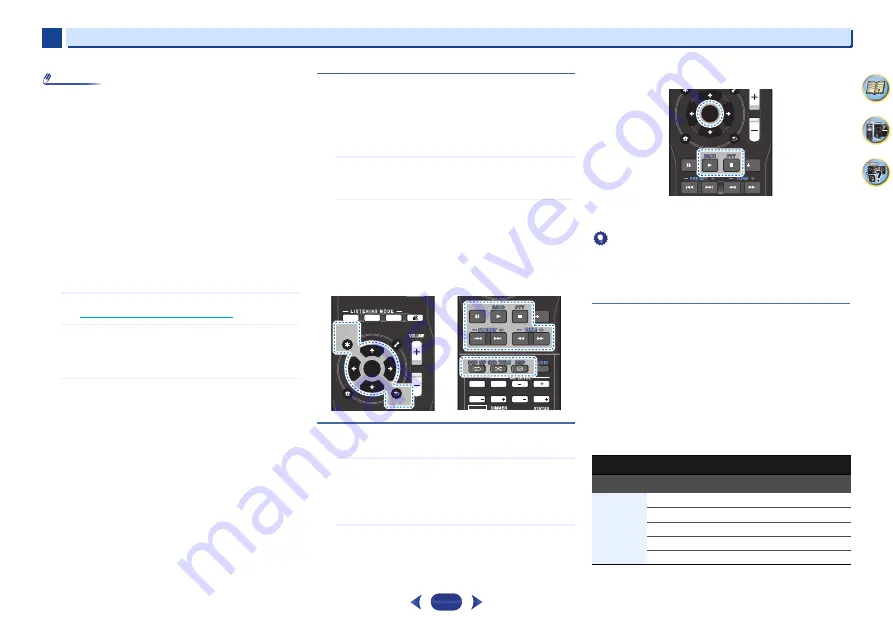
Basic playback
4
4
32
4
61
9
Note
•
Compatible USB devices include external magnetic hard
drives, portable flash memory (particularly keydrives) and
digital audio players (MP3 players) of format FAT16/32.
•
Copyrighted audio files cannot be played back on this
receiver.
•
With large amounts of data, it may take longer for the
receiver to read the contents of a USB device.
•
If the file selected cannot be played back, this receiver
automatically skips to the next file playable.
•
When the file currently being played back has no title
assigned to it, the file name is displayed in the OSD instead;
when neither the album name nor the artist name is
present, the row is displayed as a blank space.
•
Note that non-roman characters in the playlist are
displayed as ‘
#
’.
•
Make sure the receiver is in standby when disconnecting
the USB device.
1
Switch on the receiver and your TV.
See
Connecting a USB device
on page 25
.
2
Switch the TV input so that it connects to the receiver.
•
Switch the TV input to the input that connects this
receiver to the TV through the corresponding HDMI
cable.
3
Press
iPod USB
on the remote control to switch the
receiver to the iPod/USB input.
When the display shows the names of folders and files,
you’re ready to play from the USB device.
If a
USB Error
message lights in the display, try following
the points below:
•
Switch the receiver off, then on again.
•
Reconnect the USB device with the receiver switched
off.
•
Select another input source (like
BD
), then switch back
to
iPod/USB
.
•
Use a dedicated AC adapter (supplied with the device)
for USB power.
If this doesn’t remedy the problem, it is likely your USB
device is incompatible.
Playing back audio files stored on a USB memory
device
The maximum number of levels that you can select in Step 1
(below) is 9.
•
Note that non-Roman characters in the playlist are
displayed as ‘
#
’.
1
Use
/
to select a folder, then press
ENTER
to browse
that folder.
•
To return to the previous level any time, press
RETURN
.
2
Continue browsing until you arrive at what you want to
play, then press
to start playback.
Basic playback controls
This receiver’s remote control buttons can be used for basic
playback of files stored on USB devices.
•
Press
iPod USB
to switch the remote control to the iPod/
USB operation mode.
Playing back photo files stored on a USB memory
device
1
Use
/
to select a folder, then press
ENTER
to browse
that folder.
•
For high resolution files, some time may be required
for the photo to appear.
•
To return to the previous level any time, press
RETURN
.
2
Continue browsing until you arrive at what you want to
play, then press
to start playback.
The selected content is displayed in full screen and a
slideshow starts.
Basic playback controls
ENTER
,
– Starts displaying a photo and playing a slideshow.
– Stops the player and returns to the previous menu.
Tip
•
Slideshows of photo files can be played while listening to
music files by returning to the folder/file list display while
playing a music file on a USB device then playing the photo
files.
About playable file formats
The USB function of this receiver supports the following file
formats. Note that some file formats are not available for
playback although they are listed as playable file formats.
With MP3, WAV, AAC, FLAC, AIFF and Apple Lossless files,
when music files with the same format, sampling frequency,
quantization bit number and number of channels are played
successively, they are played with no gap.
-
Make sure the gap is at the minimum when using MP3 or
AAC. If you are concerned about the gap, please use
WAV or FLAC files.
Music files
MUTE
AUTO
SURR
ADV
ENTER
RETURN
AUDIO P.
TOP
MENU
HOME
MENU
TOOLS
MENU
BAND
PTY
ENTER
RETURN
AUDIO P.
TOP
MENU
CLR
SB CH
CH SEL
Fav
RETURN
HOME
MENU
SHIFT
BASS
BASS
TRE
TRE
BAND
PTY
Extension
Stream
MP3 (MPEG-1 Audio Layer 3)
.mp3
a
Sampling frequency
32 kHz, 44.1 kHz, 48 kHz
Quantization bitrate
16 bit
Channel
2 ch
Bitrate
8 kbps to 320 kbps
VBR/CBR
Supported/Supported
ENTER
Fav
RETURN
HOME
MENU
BAND
PTY
ENTER






























